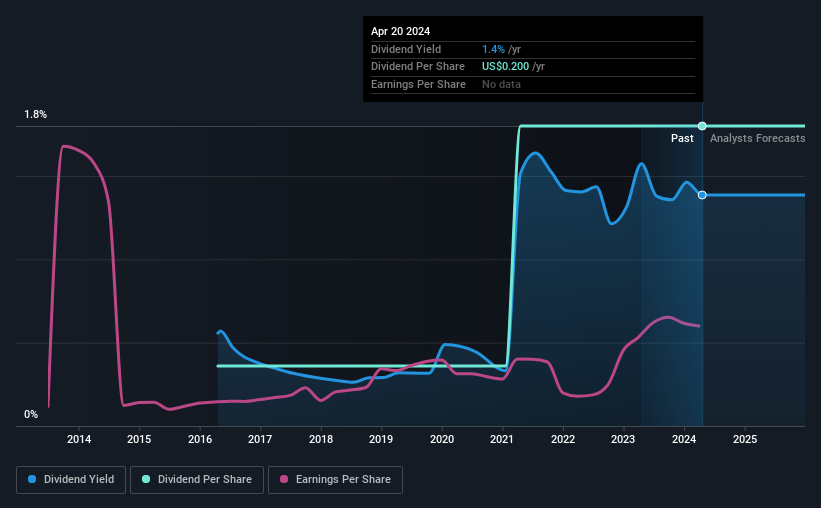Old Second Bancorp, Inc. (NASDAQ:OSBC) Passed Our Checks, And It's About To Pay A US$0.05 Dividend
Old Second Bancorp, Inc. (NASDAQ:OSBC) stock is about to trade ex-dividend in 4 days. Typically, the ex-dividend date is one business day before the record date which is the date on which a company determines the shareholders eligible to receive a dividend. The ex-dividend date is of consequence because whenever a stock is bought or sold, the trade takes at least two business day to settle. Accordingly, Old Second Bancorp investors that purchase the stock on or after the 25th of April will not receive the dividend, which will be paid on the 6th of May.
The company's next dividend payment will be US$0.05 per share, on the back of last year when the company paid a total of US$0.20 to shareholders. Calculating the last year's worth of payments shows that Old Second Bancorp has a trailing yield of 1.4% on the current share price of US$14.43. Dividends are a major contributor to investment returns for long term holders, but only if the dividend continues to be paid. So we need to investigate whether Old Second Bancorp can afford its dividend, and if the dividend could grow.
View our latest analysis for Old Second Bancorp
Dividends are typically paid out of company income, so if a company pays out more than it earned, its dividend is usually at a higher risk of being cut. Old Second Bancorp is paying out just 10.0% of its profit after tax, which is comfortably low and leaves plenty of breathing room in the case of adverse events.
When a company paid out less in dividends than it earned in profit, this generally suggests its dividend is affordable. The lower the % of its profit that it pays out, the greater the margin of safety for the dividend if the business enters a downturn.
Click here to see the company's payout ratio, plus analyst estimates of its future dividends.
Have Earnings And Dividends Been Growing?
Companies with consistently growing earnings per share generally make the best dividend stocks, as they usually find it easier to grow dividends per share. If business enters a downturn and the dividend is cut, the company could see its value fall precipitously. For this reason, we're glad to see Old Second Bancorp's earnings per share have risen 12% per annum over the last five years.
Another key way to measure a company's dividend prospects is by measuring its historical rate of dividend growth. In the last eight years, Old Second Bancorp has lifted its dividend by approximately 22% a year on average. It's great to see earnings per share growing rapidly over several years, and dividends per share growing right along with it.
To Sum It Up
Is Old Second Bancorp worth buying for its dividend? Companies like Old Second Bancorp that are growing rapidly and paying out a low fraction of earnings, are usually reinvesting heavily in their business. This strategy can add significant value to shareholders over the long term - as long as it's done without issuing too many new shares. We think this is a pretty attractive combination, and would be interested in investigating Old Second Bancorp more closely.
While it's tempting to invest in Old Second Bancorp for the dividends alone, you should always be mindful of the risks involved. For example - Old Second Bancorp has 1 warning sign we think you should be aware of.
If you're in the market for strong dividend payers, we recommend checking our selection of top dividend stocks.
Have feedback on this article? Concerned about the content? Get in touch with us directly. Alternatively, email editorial-team (at) simplywallst.com.
This article by Simply Wall St is general in nature. We provide commentary based on historical data and analyst forecasts only using an unbiased methodology and our articles are not intended to be financial advice. It does not constitute a recommendation to buy or sell any stock, and does not take account of your objectives, or your financial situation. We aim to bring you long-term focused analysis driven by fundamental data. Note that our analysis may not factor in the latest price-sensitive company announcements or qualitative material. Simply Wall St has no position in any stocks mentioned.

